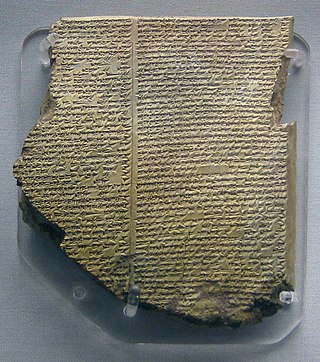
An epic poem, or simply an epic, is a lengthy narrative poem typically about the extraordinary deeds of extraordinary characters who, in dealings with gods or other superhuman forces, gave shape to the mortal universe for their descendants.
Ṛtusaṃhāra, often written Ritusamhara, is a medium length Sanskrit poem.
Hindi literature includes literature in the various Hindi languages which have different writing systems. Earliest forms of Hindi literature are attested in poetry of Apabhraṃśa like Awadhi, Magadhi, Ardhamagadhi and Marwari languages. Hindi literature is composed in three broad styles- गद्य (Gadya-prose), पद्य( Padya- poetry) and चम्प्पू In terms of historical development, it is broadly classified into five prominent forms (genres) based on the date of production. They are:

Edward Stachura(listen) was a Polish poet, writer and translator. He rose to prominence in the 1960s, receiving prizes for both poetry and prose. His literary output includes four volumes of poetry, three collections of short stories, two novels, a book of essays, and the final work, Fabula rasa, which is difficult to classify. In addition to writing, Stachura translated literature from Spanish and French, most notably works of Jorge Luis Borges, Gaston Miron and Michel Deguy. He also wrote songs, and occasionally performed them. He committed suicide at the age of forty-one.

Mahmoud Darwish was a Palestinian poet and author who was regarded as Palestine's national poet. He won numerous awards for his works. Darwish used Palestine as a metaphor for the loss of Eden, birth and resurrection, and the anguish of dispossession and exile. He has been described as incarnating and reflecting "the tradition of the political poet in Islam, the man of action whose action is poetry." He also served as an editor for several literary magazines in Palestine.
Govind Vinayak Karandikar, better known as Vindā, was an Indian poet, writer, literary critic, and translator in the Marathi-language.
Kumārasaṃbhavam is an epic poem by Kālidāsa. It is widely regarded as the finest work of Kālidāsa as well as the greatest kāvya poem in Classical Sanskrit. The style of description of spring set the standard for nature metaphors pervading many centuries of Indian literary tradition. Kumārasaṃbhavam basically talks about the birth of Kumara (Kārtikeya), the son of Shiva and Parvati. The period of composition is uncertain, although Kālidāsa is thought to have lived in the 5th century.
The history of Gujarati literature may be traced to 1000 AD, and this literature has flourished since then to the present. It is unique in having almost no patronage from a ruling dynasty, other than its composers.
Professor Debi Prasad Chattopadhyaya, was educated at the University of Calcutta and was Deputy Minister of Health of India and Union Minister of Commerce and Industry. He founded the Indian Council of Philosophical Research, New Delhi, and served as its Chairman. Till the end of his life, he served as the Chairman of the Centre for Studies in Civilizations, and General Editor of the Project of History of Indian Science, Philosophy and Culture, which produced a multi-volume cultural history of India.

Swedish Romantic literature denotes Swedish literature between 1809 and 1830. In Europe, the period from circa 1805–1840 is known as Romanticism. It was also strongly featured in Sweden, based on German influences. During this relatively short period, there were so many great Swedish poets, that the era is referred to as the Golden Age of Swedish poetry. The period started around 1810 when several periodicals were published that contested the literature of the 18th century. An important society was the Gothic Society (1811), and their periodical Iduna, a romanticised retrospect to Gothicismus.

Vaiṣṇava Sahajiyā was a form of Hindu tantric Vaishnavism focused on Radha Krishna worship that developed in Eastern India. This tradition flourished from the 16th to the 19th century. The Vaiṣṇava Sahajiyā tradition produced many great poets who wrote in the Bengali language, the most famous of these poets all wrote under the pen name Chandidas. Their religious literature was mainly written in Bengali vernacular.
Viśvanātha Kavirāja, most widely known for his masterpiece in aesthetics, Sāhityadarpaṇa, was a prolific poet, scholar, and rhetorician who ascended literary heights during the reigns of two successive Eastern Ganga rulers of Kalinga (India) – King Narasimha Deva IV and King Nishanka Bhanudeva IV. In absence of availability of exact dates of his birth and date, the periods of their rules is assumed to be the time of Viswanatha.

Heikki Johannes Silvennoinen is a Finnish musician and an actor. He was a guitarist and a songwriter in several notable Finnish bands in the 1970s and 1980s, and has also recorded solo albums. He is best known in Finland as a member of comedy group Kummeli, which started a television show in 1991.

Mangesh Keshav Padgaoankar was a legendary Marathi poet from Maharashtra, India.
The Eino Leino Prize is an annual prize award to top writers in Finland since 1956, with particular emphasis on poets.
Indian art evolved with an emphasis on inducing special spiritual or philosophical states in the audience, or with representing them symbolically.

Jagadguru Ramanandacharya Swami Rambhadracharya is a Hindu religious leader, Sanskrit scholar and Katha artist based in Chitrakoot, India. Rambhadracharya is a spontaneous poet and writer in Sanskrit, Hindi, Awadhi, Maithili, and several other languages. He has authored more than 100 books and 50 papers, including four epic poems, a Hindi commentary on Tulsidas' Ramcharitmanas, a Sanskrit commentary in verse on the Ashtadhyayi, and Sanskrit commentaries on the Prasthanatrayi scriptures. He is regarded as one of the greatest authorities on Tulsidas in India, and is the editor of a critical edition of the Ramcharitmanas.
Jinaharsha was a Jain ascetic poet who lived in 17th and 18th century.
Jinadattasuri was a Jain Apabhramsa poet.

Ruth Helena Anhava was a prolific Finnish poet, author and translator. Her translations include novels, plays, lyrics and dozens of auditions.









